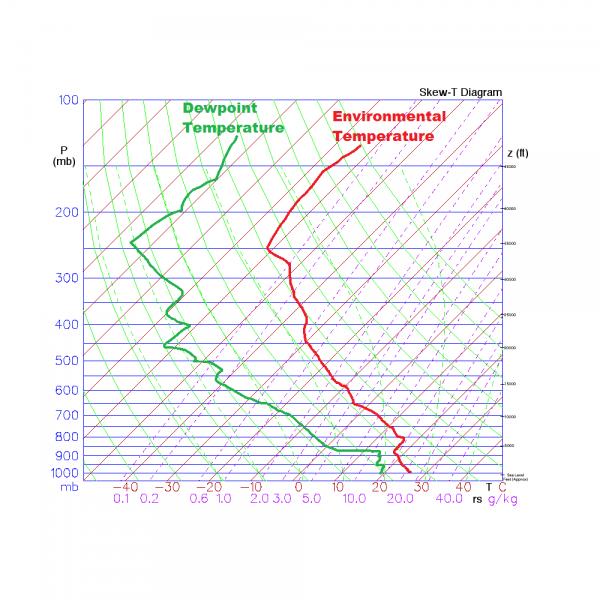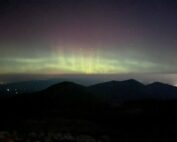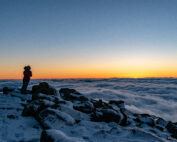Skew-T Plots
2016-09-19 07:06:26.000 – Taylor Regan, Summit Intern
There’s never a shortage of things to learn on the summit. Due in part to Mt. Washington’s location and surrounding topography, this mountain is ideally situated, and those living on the summit, uniquely fortunate, to experience some very exciting and very extreme weather phenomena.
Predicting weather is no easy task, nor, one could argue, is observing it, on the summit of New Hampshire’s tallest peak. So, what sort of tools are used by meteorologists and observers in order to get a better handle on just what the atmosphere is up to? One such forecasting aid is a skew-t plot.
 Example Skew-T Plot [4]
Example Skew-T Plot [4]Being able to look at the temperature and dew point vertical profiles has several advantages. These profiles, and their comparison, allow one to assess instability in the atmosphere, as well as characterize severe weather and observe a variety of weather elements as they occur in each layer of the atmosphere. [2] Additionally, information gathered through radiosonde data and its plotting on a skew-t plot can be used to develop large-scale forecast models, by allowing the forecaster to look at a vertical “slice” of the earth’s atmosphere. [2]
A few caveats to be aware of when looking at a skew-t plot are that, as the data is collected via weather balloon ascent, the profile is not truly vertical, as there is some drift associated with the “float” of the balloon downstream, and that it is also not truly representative of an instant vertical slice of the atmosphere, as there are several minutes consumed by the ascent of the balloon, but it is typically close enough that these assumptions can be made. [2]
A plethora of information is contained in these somewhat-convoluted plots, and understanding the plot design helps in interpreting the data it contains. Firstly, the solid horizontal lines represent isobars, or areas of equal pressure. The pressure axis goes from 1050 mb, or roughly sea level, to 100 mb, plotted on a log scale. [3] Additionally, there are isotherms, or lines of equal temperature. These slope from the bottom left to the upper right, and their skewed nature is the namesake for the plot itself. Other reference lines on the plot include saturation mixing lines, adiabatic lapse rates, and wind speed and direction. I’m looking forward to learning to identify specific weather conditions through analyzing the skew-t plot!
[1] https://en.wikipedia.org/wiki/Skew-T_log-P_diagram [2] http://www.theweatherprediction.com/thermo/skewt/ [3] http://www.atmos.millersville.edu/~lead/SkewT_HowTo.html [4] http://wx4cast.blogspot.com/2011/10/how-to-read-skew-t-log-p.html
Taylor Regan, Summit Intern
From Weather Observer to Intern, to Observer Again
From Weather Observer to Intern, to Observer Again By Madelynn Smith As I rode in the backseat of our Obs van up the Auto Road for the first time as a full-time employee at
From Mountains to More Mountains
From Mountains to More Mountains: This Time with Stronger Winds By Alyssa Bélanger On the observation deck in high winds. Hello there! My name is Alyssa Bélanger and I am a fall
From Summit to Sign-Off: My Farewell to the Rockpile
From Summit to Sign-Off: My Farewell to the Rockpile By Amy Cotter Enjoying my last Mount Washington sunset (for now) on September 13, 2025. After two incredible years with the Mount Washington




